Read About Pyramid Lake Fisheries Departments
There are four departments within the administration of Pyramid Lake Fisheries: Maintenance, Human Resources and Employment; Production; and Resources and Biology. The production department features four facilities for producing the trout so coveted by the angling public. Each year up to a million trout are reared in these hatcheries for release in the fall. Cui-ui is reared in two different hatcheries to supplement the natural recruitment during years when low river flows fail to attract a Cui-ui run. Human Resources manages our federal grant income, handles the payroll, hires new employees, and coordinates all our visitation. Maintenance has a big job in keeping up the complex network of plumbing and electrical needs and keeping up buildings and access roads. Resources and Biology are the links between the fish that are stocked each year and the dynamic ecosystem of the lower Truckee River and the lake.
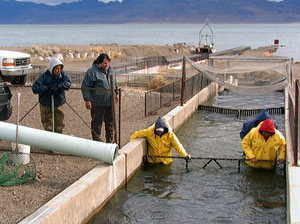
Hatchery personnel crowd fish at the spawning channel to begin sorting males and females for spawning.

Human Resources and Employment
Our Department is composed of the executive director, the finance manager, and the receptionist. The executive director oversees the managers in all departments and is responsible for the management and administration of the Pyramid Lake Fisheries (PLF) Program. The executive director coordinates the overall planning, fiscal management, personnel management, and inter-departmental programs. He develops and maintains liaisons with Federal, State, and local agencies and the public to ensure that the Fisheries Program is consistent with all Federal, State, and local regulations.
The finance manager maintains financial records, reports, and internal operations for a Tribal Finance Department and supervises the assigned administrative staff in performing their clerical and record-keeping duties. Visitations, license sales, hatchery tours, and coordination with the Pyramid Lake Fisheries Board are handled by our receptionist, who will greet you in the front office of our Administrative Building at 603 Sutcliffe Drive.
Production
Currently, the production department is made up of the Production Manager, hatchery managers for each facility, four full-time fish culturists, and 2 to 5 part-time culturists who assist seasonally during the spring spawning period or at the peak of production. The Production manager plans, organizes, and directs all operations and programs associated with the Pyramid Lake Fisheries (PLF) hatchery production program. PLF maintains three facilities for the production of Lahontan cut-throat trout: Dunn Hatchery, Numana Hatchery, and Lake Operations. There are also two smaller hatcheries for Cui-ui production: the Koch Hatchery and the Big Bend facility.
In 1975 the Dunn Hatchery was completed, followed by the Lake Operations facility in 1980 and Numana Hatchery in 1982, all geared towards the propagation of cut-throat trout. In 2009, funding for hatchery improvements was received through a High Desert Terminal Lakes Grant. Our three trout-rearing facilities were fitted with state-of-the-art filtration systems to remove ammonia and nitrates, improving water quality for recycling in each hatchery. Each of these hatcheries also received new ultra-violet curing systems to disinfect water during egg incubation. With improved water quality, chemical treatments are no longer needed for the control of fish diseases.
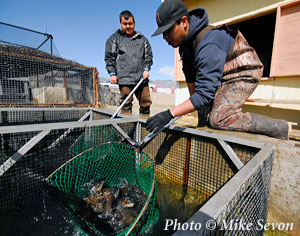
Each year, Pyramid Lake Fisheries hires temporary employees to assist during the busiest time of the hatchery cycle. Here two temporary workers net fish from the spawning channel for use in collecting eggs.
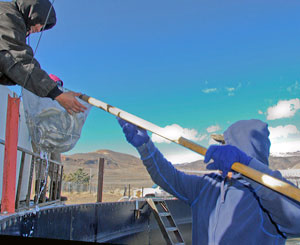
Hatchery culturists net fish from a circular tank at Lake Operations.
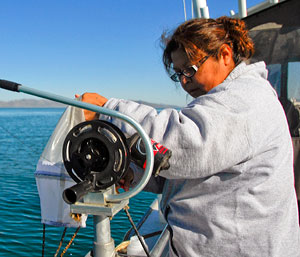
Sarah prepares to deploy a plankton tow net.
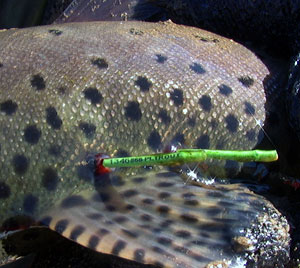
Fish tagging is an important program at Pyramid Lake Fisheries. All tagged fish have an adipose fin removed. They may have a visible floy tag, as seen in this photo, a visible elastomer marking, or a micro-nose tag. Anglers are asked to provide us with information on any tagged fish they encounter.
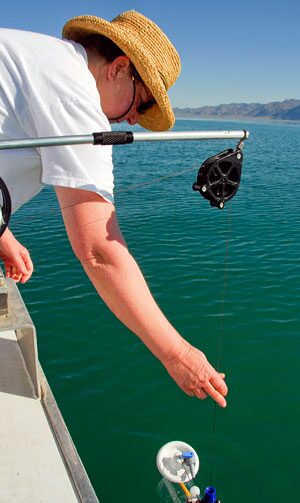
Nancy lowers a water bottle to collect samples for water quality.
Resources and Biology
The Resource/Biology Department coordinates the scientific management and study of hatcheries, wild fish populations, and the aquatic environment of Pyramid Lake and the Truckee River. Our fisheries biologist manages the laboratory, a field crew of two fish technicians, and a creel census program to keep a pulse on the success of stocked cut-throat trout and their interactions with the other fish and biota of Pyramid Lake and the lower Truckee River. Population sampling with experimental gillnets is conducted at 6 established sites on Pyramid Lake on a quarterly basis.
Pyramid Lake Fisheries (PLF) has maintained an active micro-tagging program through 2005, marking 10 to 15% of all fish reared. From 2000 to 2005, over 830,000 cut-throat trout were tagged and released to Pyramid Lake. Micro-tagging was not done from 2005 through 2010. During this period, the US Fish and Wildlife Service was floy-tagging all of the Pilot Peak strain fish released in the lake. From 2006 through 2010, 334,399 Pilot Peak strain fish were released to Pyramid Lake or the lower Truckee River. All fish that are tagged and released to Pyramid Lake also have clipped adipose fins to assist in tag recoveries. The Resource Department is responsible for tracking tagged fish that are returned in the spawning channel or through angler surveys.
Monitoring the annual recruitment of Tui chub, Tahoe sucker, and Cui-ui is done through beach seining transects during the period from June through August. The fisheries biologist also coordinates annual fish disease sampling between PLF and the US Fish and Wildlife California-Nevada Fish Health Center in Anderson, California.
Monitoring water quality is an important task of the Resource/Biology Department. The lake Water Quality Monitoring Program began in 1986. Two sites were selected for long-term monitoring, with Station 96 located in the deepest water and Station 93 located within the shallow basin of Pyramid Lake. An SBE SEACAT Profiler is used to measure and record temperature, pH, specific conductivity, total dissolved solids (TDS), dissolved oxygen, and a light profile from the surface to the bottom.
As this basin is influenced by the Truckee river, especially during moderate to high flow events, quarterly water samples are collected at discrete depths from the surface to 5 meters above the bottom at station 93. Water samples are processed, preserved, and analyzed following protocols in the Tribe’s Quality Assurance Project.
The Water Quality Monitoring Program was expanded in 1999 to include streams and 5 sites along the lower Truckee River. With the increase in the scope of water quality sampling, the Resources Department teamed with the PLPT Environmental Dept. to collect and analyze samples.
Also, see The Water Quality Laboratory and the Pyramid Lake Paiute Tribe Water Quality Monitoring Website.
Maintenance
The primary job of the Maintenance Department is to plan, organize and direct building and grounds maintenance, repair, custodial work, security functions, fleet maintenance, and capital improvements at Pyramid Lake Fisheries (PLF) facilities. The crew consists of a Manager, a Foreman, and one to two full-time Maintenance workers. The Maintenance Department keeps the hatcheries operating year around. Duties vary and do not end when hatcheries shut down. Between the time when fish are stocked in the fall and eggs arrive in the spring, this department provides annual preventive maintenance to the hatchery systems, electrical controls, plumbing, HVAC, and all vehicles. Heavy equipment is in constant use to provide access to lake fish stocking sites and road access on the west shore.
Occasionally, we have to assist the hatchery personnel in getting fishy.
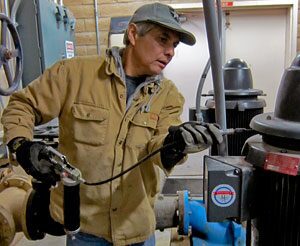
Robert lubricating a pump motor at the Dunn Hatchery.
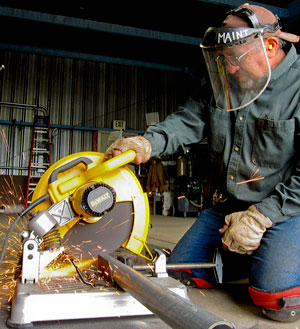
Stan cutting pipe for new signs for Aquatic Invasive Species Education.
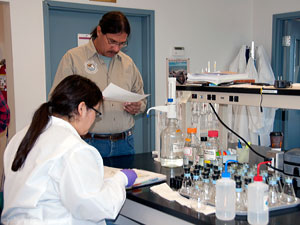
Testing at the Water Quality Laboratory.
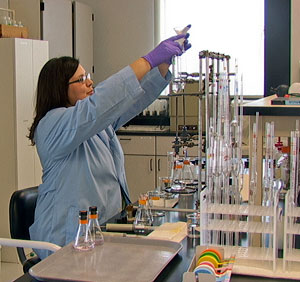
Fanny Ely titrating a water quality sample.
Water Quality Laboratory
Located next to the Fisheries Administration building in Sutcliffe, the water quality laboratory was constructed in 2002 to facilitate testing and analysis of surface water samples gathered from the reservation and water quality and fish health monitoring in the Tribe’s trout and Cui-ui hatcheries. The lab is equipped to analyze for total ammonia, nitrate/nitrite, total Kjeldahl nitrogen, total phosphate, and orthophosphate. Measurements of physical parameters include temperature, dissolved oxygen, pH, salinity, and conductivity.
Nitrogen and phosphorus are important parameters to monitor because they are the nutrients needed for primary production (e.g., algal growth), which drives the entire food chain. In the hatcheries, nitrogen (ammonia and nitrite) can rise to toxic levels because approximately 80% of the water in the hatchery is recycled, and the biological filters cannot remove all the fish waste products.
The lab uses EPA-approved analytical procedures for all environmental samples. Standard operating procedures include test descriptions, equipment, calibration requirements, and analytical procedures. An extensive quality control program is designed to ensure data integrity, precision, and accuracy.
The fish health lab tests fish for common diseases before they can be planted in the Lake or River. Samples of gill, liver, kidney, and spleen are routinely tested for diseases such as furunculosis, bacterial kidney disease, bacterial gill disease, infectious hepatic necrosis, viral hemorrhagic septicemia, and infectious pancreatic necrosis.
The most common equipment used in the laboratory includes reverse osmosis, and distillation and deionization units for making reagent-grade water; analytical scales; fume hoods; block digestors; water baths; spectrophotometers; pH and dissolved oxygen meters; nitrate reduction columns; autoclave; and bacterial incubators. A variety of reagent-grade chemicals are used in the analytical process, and lab waste is disposed of according to federal and local regulations.
Aquatic Invasive Species
Don’t Move a Mussel!
Invasive mussels are in Nevada! Quagga mussels have been found in Lake Mead, Lake Mohave, and more recently in Lahontan Reservoir and Rye Patch Reservoir. Mud, plants, and animals that may be lurking on your watercraft, trailer, vehicle, or on other recreational equipment will cause the spread of invasive mussels. Invasive mussels cause millions of dollars of damage to boats and water systems by clogging pipes and engines. They also impact the native ecosystem and sports fisheries.
Quagga and Zebra Mussels
Quagga mussels (Dreissena bugensis) and zebra mussels (Dreissena polymorpha) are freshwater mollusks that typically have a zebra-like pattern on their shells. They are alien to North America. Quagga mussels have spread throughout the Great Lakes, the Ohio River Basin, and the Mississippi River Basin. Colonies have been discovered as far west as Oklahoma.
The potential for quagga mussels to spread to Western states is very high. They can spread to other inland waters either in their immature form transported in water hidden in -live wells, bilge, and motors or as adults attached to boat hulls, engines, aquatic weeds, or other surfaces.
Since quagga mussels spread to Lake Mead and Lake Mohave, they will potentially cost millions of dollars by clogging engines and encrusting boats and facilities, disrupting the food chain, disrupting sport fishing, and littering beaches with sharp smelly shells.

Aquatic Invasive Species Information Resource Links
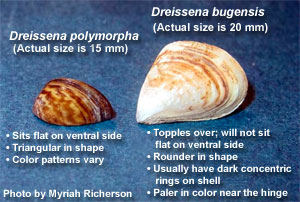
Zebra and Quagga mussels.
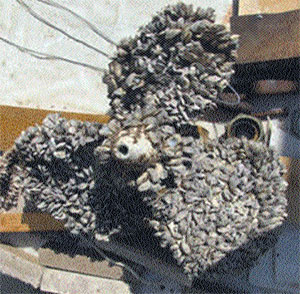
Mussels on a boat propeller.
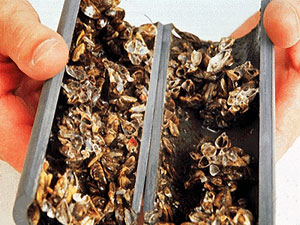
Zebra mussels inside a pipe.

We’re all in this boat together.
